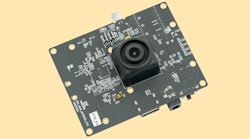Automotive Camera/ISP Pair Provides 120-dB HDR and Highest LED-Flicker Mitigation
>> Microwaves & RF Resources
.. >> Top Stories of the Week
.. .. >> CES 2021
For automotive applications involving rear-view cameras, surround-view systems, and e-mirrors for low-end and midrange vehicles, OmniVision Technologies and Nextchip have partnered on a joint solution that is pre-tuned, saving developers up to three months of tuning efforts. The solution includes OmniVision’s OX03C10, which is claimed to be the world’s only automotive image sensor to combine a large 3.0-µm-pixel, high dynamic range (HDR) sensor of up to 140 dB for minimized motion artifacts, and the highest LED flicker mitigation (LFM) performance.
It also features Nextchip’s NVP2650D image signal processor (ISP), which integrates two NVP2650 ISP cores in a single package, can simultaneously process the captures from two OX03C10 sensors, providing dual and full LFM image outputs at 60 frames per second (fps) using a single ISP. Additionally, the NVP2650D provides a combined 10/12-bit compressed RAW output and 24-bit uncompressed HDR output to further enhance the image quality for scenes with widely contrasting light and dark areas.
This sensor’s integration of OmniVision’s HALE (HDR and LFM engine) combination algorithm uniquely provides the highest HDR and LFM performance simultaneously, while its Deep Well dual-conversion gain technology significantly reduces motion artifacts. Additionally, OmniVision’s split-pixel LFM technology with four captures is said to provide the industry’s best performance over the entire automotive temperature range. The OX03C10 is also the first viewing image sensor with HDR and LFM that can deliver 1920 x 1280p resolution at 60 fps, enabling greater design flexibility and faster camera-view switching for drivers. With the lowest power consumption of any 2.5MP LFM image sensor—25% lower than the nearest competitor—along with the industry’s smallest package size, enabling the placement of cameras that continuously run at 60 fps in even the tightest spaces, the OX03C10 has a market-leading position in automotive imaging applications.
OmniVision’s PureCel Plus-S stacked architecture enables pixel performance advantages in the OX03C10 over non-stacked technology, in addition to a smaller die and lower power consumption. For example, 3D stacking allowed OmniVision to boost pixel and dark current performance, resulting in a 20% improvement in the signal-to-noise ratio over the prior generation of its 2.5-MP automotive viewing sensors.
This joint solution provides the automotive industry’s lowest power consumption for automotive viewing cameras with 120-dB HDR and full 2.5-MP resolution at 60 fps. By owning the ISP core, Nextchip can deliver the right image quality to each customer based on its knowledge and experience in image processing. Additionally, the NVP2650D ISP offers 4-lane, 2-channel MIPI output, at 1 Gbps for each lane, along with support for a virtual channel.
OmniVision’s OX03C10 image sensor is available for sampling, and Nextchip’s NVP2650D ISP is in mass production. Both companies’ devices provide advanced ASIL functional safety and AEC-Q100 Grade 2 certification for automotive applications.
CES Note: Visit OmniVision’s virtual meeting portal to schedule a meeting and view demo videos during CES. These videos will demonstrate the excellent color images produced by this joint solution, as well as the top HDR and LFM performance that can be achieved when exiting a tunnel while viewing LED signs and traffic signals. A second video shot at night will demonstrate the top low-light performance of this joint solution.
OmniVision, www.ovt.com; Nextchip, www.nextchip.com

